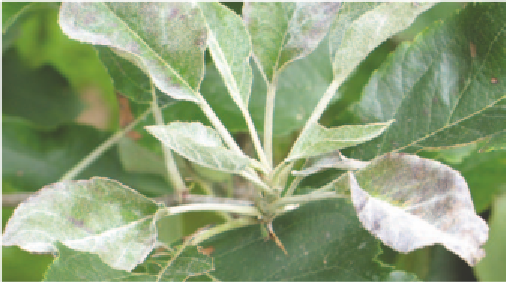Agriculture Reference
In-Depth Information
Management
•
Grow trees in well-drained soils, and manage irrigation
so that soils are never waterlogged.
•
Spray with fungicides, especially from green tip to 95%
petal fall.
In areas where Phytophthora is likely to be a problem,
avoid planting in low spots in the orchards; instead,
plant on mounds to improve drainage.
•
Apply the recommended pre-leaf-fall spray.
•
PHYTOPHTHORA TRUNK, COLLAR
AND ROOT ROTS
Apply registered fungicides as preventative or curative
treatments.
•
Cause
Several species of the oomycete
Phytophthora
infect apple,
pear and stone fruit in Australia.
POWDERY MILDEW OF APPLE
■
Cause
The fungus
Podosphaera leucotricha
.
Symptoms
Leaves: yellowing, wilting and premature leaf fall. These
general symptoms are a result of water stress and are very
similar to the above-ground symptoms caused
by
Rosellinia
sp. or other root rotting organisms.
Symptoms
The powdery mildew fungus grows as a parasite on the
surface of leaves, shoots, twigs, blossoms and fruit,
extracting nutrients from underlying tissues.
Trunk and collar: long, wide, sunken cankers can extend
from just below ground level to the first branches and
involve up to half the circumference of the trunk. Beneath
the sunken bark, an orange-brown discolouration develops
in the wood. In severe cases, these cankers can ringbark
and kill the tree. Copious orange-red gum may exude from
the edge of active cankers.
Lesions can be confused with those caused by bacterial
canker. However, there are three distinctive differences:
Phytophthora cankers smell sickly sweet while bacterial
cankers smell sour; Phytophthora cankers develop in the
summer while bacterial cankers develop in the winter; and
Phytophthora trunk cankers develop from the roots up, while
bacterial trunk cankers develop from the branches down.
Leaves: white to light grey powdery patches develop rapidly
to cover both leaf surfaces, causing curling, stunting and
death.
Twigs: a similar white, powdery growth to that on the leaves
causes stunting and dieback. Tips of fruiting twigs and of
terminal growth shoots are extremely vulnerable. The fruit
and leaf buds become coated with mildew and fail to develop
fully. Affected blossoms frequently wither and fruit fails to set.
Fruit: powdery mildew manifests itself as a skin russet
composed of a maze of fine lines, often appearing as a
solid patch. Fruit size may be reduced.
Source of infection and spread
The fungus overwinters in dormant f flower and leaf buds.
It resumes growth in spring and infects new leaves and
blossoms particularly from the pink stage onwards. Large
numbers of spores are produced and are spread by wind
and rain to adjacent trees.
Roots: white feeder roots turn brown and rot. Larger roots
may develop brown-black lesions.
Source of infection and spread
Refer to the chapter on Common diseases of perennial fruit
crops.
Importance
Phytophthora
trunk, root and collar rots can be an important
cause of tree death and decline in Australian pome and
stone fruit orchards. Orchards established in poorly drained
locations are particularly prone to the disease.
Management
•
Once established, Phytophthora is very diffi cult
to manage and impossible to eradicate, so disease
management should focus on prevention.
Fig 3.27 Powdery mildew on apple showing a dense white mat
and leafcurl.
Plant disease-free nursery trees.
•












